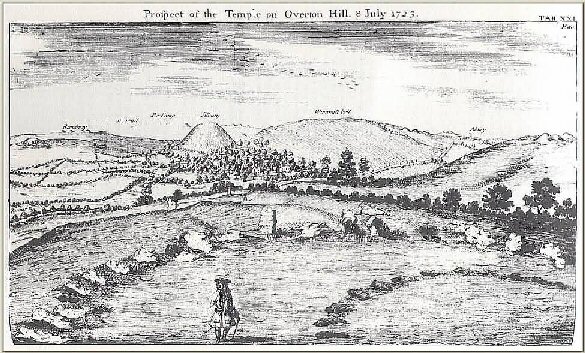|
Location:
Wiltshire, England.
(O/S SU119680) |
Grid Reference:
51.41� N, 1.83� W. |

 The Sanctuary:
(Concentric Stone Circles.).
The Sanctuary:
(Concentric Stone Circles.).
The Sanctuary, situated on Overton Hill next to the Ridgeway and near
Avebury, was begun around 3,000 BC.
(1). It originally comprised
six concentric rings of timber uprights. Later, the timbers were replaced
by two double stone circles of sarsen stones, the largest being 39.5m in
diameter. The site, of which only the post and stone holes remain today
(now marked by concrete blocks) was destroyed in 1723 and 1724
for farming land, but not before
William Stukeley made a drawing of it.
For
Stukeley, the Sanctuary represented the head of a great stone serpent
the body of which was formed by the West Kennet Avenue, Avebury and the Beckhampton
Avenue.
The Sanctuary sits almost at the end on the Ridgeway, and
would have been on the natural route to Avebury/Silbury complex for
anyone travelling there. Dating suggests that the first structures were
there slightly before the construction of either Avebury or Silbury
Hill, although other prominent structures such as West Kennet and
Windmill hill henge etc.
(Location
of the Sanctuary in relation to the Avebury-Silbury landscape)
Much of what once existed here
will remain speculation. It seems that the site was host to
large wooden roundhouse here, with archaeological evidence of
ceremonial activities and feasting. It is suggested that the
roundhouse was increased in size twice, leaving three
progressively larger sets of concentric holes. Somewhere around
2,100 BC (2), two
concentric circles of stone were set in its place.
In the 1930's, the Cunningtons
excavated Beaker items from this phase including the remains of an
adolescent interred with a pot (2).

Silbury Hill (behind 'Waden hill')
from the Sanctuary.

The only surviving image with the
original stones in place. (1723. W. Stuckeley)
Extract From: (The
Ancient History of Wiltshire by Sir Richard Colt Hoare).
'It was, (alas! it was) a very few
years ago, crowned with a most beautiful temple of the druids. They
still call it the Sanctuary. I doubt not but it was an asylum in Druid
times, and the veneration of it has been handed down through all
succession of times and people. It had suffered a great deal when I took
the prospect of it with great fidelity, in 1723. Then farmer Green took
most of the stones away to his building at Beckhampton, and in the year
1724 farmer Griffin ploughed half of it up; but the vacancy of every
stone was most obvious, the hollows still left fresh. In the winter of
the same year, the rest were carried off, and the ground ploughed over'

Stuckeley believed that the
Sanctuary was the 'head' or 'Hakpen' of a huge ceremonial 'snake'
formed across the landscape with the West Kennet and Beckhampton
avenues.
The Significance of the Sanctuary.
The Sanctuary is an important part of the both the local landscape and is
integral to the overall design of the Salisbury Landscape. It not only lies
at the foot of the Ridgeway and The West-Kennet River, but represents the
first step in a ceremonial route that leads to Avebury, then the Beckhampton
Cove (avoiding Silbury altogether), via the West Kennet and Beckhampton
Avenues, built 500 years later and revealing the continuing importance of
the location as the entrance to the whole complex. It is also incidentally,
one of the only local vantage points from which all the other important
sites in the area can be seen at the same time.
The megalithic ruins on the Salisbury landscape can be seen as integral
parts of an overall design on Salisbury. although it is difficult to see
today, these monuments were deliberately positioned in order to align with
each other, astronomical observations and the natural landscape features on
Salisbury. We can see for example, that The Sanctuary was positioned exactly
1.4� North of Stonehenge, and on the same line of longitude, suggesting a
placement of these two sites at a deliberate distance apart, encompassing
earthly measurements. There are indications that this form of separation was
carried out at other prominent British sites, extending out from Stonehenge,
leading to the proposition that the Avebury/Stonehenge complex may be the
remains of a prehistoric Meridian.
(More about the Salisbury Complex)
(Other European Megalithic Complexes)
(Silbury Hill) (West
Kennet Long Barrow) (The
Sanctuary)
(Other Prehistoric English sites)
|